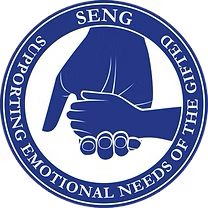Few current topics in education have engendered as much attention, concern, and passion as Attention-Deficit/Hyperactivity Disorder (ADHD), particularly in gifted children. We recognize that giftedness is multifaceted and can be assessed in many ways other than a standardized IQ test. We will summarize and differentiate between what is known and what is assumed about ADHD in gifted students. (See our NRC/GT monograph for a complete analysis of this topic.)
ADHD: History, Definition, and Etiology
Attention-Deficit/Hyperactivity Disorder (ADHD) is a “syndrome,” i.e., a grouping of symptoms that typically occur together. The core symptoms of ADHD are impulsivity, inattention, and hyperactivity (American Psychiatric Association, 1994). Estimates of the prevalence of ADHD among school age children vary but the median estimate across all definitions of ADHD and all types of studies is 2% in boys and girls combined (Lahey, Miller, Gordon, & Riley, 1999).
Family, adoption, and twin studies demonstrate that genetic factors are very important in ADHD, but environmental factors also play a significant role since heritability is less than 100%. Environmental factors, including premature birth, head injury, fetal alcohol syndrome, prenatal exposure to drugs of abuse, such as cocaine, lead toxicity, prenatal maternal smoking, and rare endocrine abnormalities can all cause the ADHD syndrome.
How Is ADHD Assessed and Diagnosed?
Four subtypes of Attention-Deficit/Hyperactivity Disorder (ADHD) are recognized in the DSM-IV: Predominantly Hyperactive/Impulsive, Predominantly Inattentive, Combined, and Not Otherwise Specified (American Psychiatric Association, 1994). To meet the criteria for one of the specific subtypes, at least 6 of the 9 symptoms of hyperactivity/impulsivity, or at least 6 criteria from the 9 symptoms of inattention must be present. The symptoms must occur in more than one setting, must persist for at least 6 months, and must affect the individual “to a degree that is maladaptive and inconsistent with developmental level” (American Psychiatric Association, 1994, p. 83).
Under optimal circumstances, a team, including a qualified clinician, such as a pediatrician, family physician, psychiatrist, neurologist, or psychologist should make the diagnosis of ADHD because only these types of specialists can assess the physical and psychological problems that mimic ADHD. Information about these conditions is rarely available to school personnel, no matter how observant, experienced, or well trained.
For the majority of children with ADHD, symptoms become clear-cut when their behavior can be observed regularly and compared to other children over a sustained period. The classroom teacher, therefore, is typically the best person to make such comparisons, especially when systematic behavioral checklists or rating scales are employed. When the child in question is gifted, an individual who specializes in giftedness should also be included in the process to provide information about the child’s behavior in comparison to other children of similar abilities (Silverman, 1998).
ADHD or Gifted: Either or Both?
In recent years, several authors have expressed concern that giftedness is often misconstrued as ADHD and that the diagnosis of ADHD among the gifted population has run amok. We acknowledge that there are cases of mistaken diagnosis, although we have found no empirical data in the medical, educational, or psychological literature to substantiate the extent of this concern.
The lack of scientific data heightens our dismay over the wave of skepticism that appears to prevail about the existence of ADHD in gifted children. Specifically, we are concerned that the question “ADHD or gifted?” dismisses the possibility that the two conditions may coexist. Prudent attempts to avoid over-diagnosis must be balanced against a child’s need for evaluation and treatment in the context of inevitable uncertainty when medical diagnoses are invoked.
Some professionals erroneously assume that a child who demonstrates sustained attention, such as a gifted child engaged in a high-interest activity, cannot have ADHD. While this state of rapt attention is often described as “flow,” it can also be ascribed to “hyperfocus,” a condition that individuals with ADHD frequently experience.
Activities that are continuously reinforcing and “automatic,” such as video or computer games or reading for pleasure, do not distinguish children who have ADHD from children who do not have ADHD, whereas effortful tasks do. By virtue of their giftedness, the range of tasks that are perceived as “effortless” is broader for gifted children, which is why their ADHD may be less apparent.
Recent work suggests that the gifted child with ADHD is particularly predisposed to exhibit this state of “flow” or “hyperfocus.” While this can be a positive aspect of task commitment, it becomes a problem when the child is asked to shift from one task to another. ADHD involves difficulty regulating attention to tasks that are not intrinsically rewarding or that require effort.
While a misdiagnosis of ADHD is undesirable, diagnostic errors of omission are just as serious and may be more prevalent among gifted students. Over-reliance on strengths can inadvertently obscure a disability and prevent a child from learning compensatory or coping skills.
We believe acknowledging that a child can be both gifted and have ADHD, and exploring how these conditions interact in each child, is more productive than agonizing about a false dichotomy.
Given the realities of co-existence, the question should be “how impaired is this student by his/her ADHD?” Some children compensate in most situations; others are seriously handicapped. The single most relevant element in evaluating ADHD is the degree of impairment experienced as a result of the behaviors.
A child whose behavior causes impairment academically, socially, or in self-development should be examined clinically to exclude treatable conditions, even if behavior resembles traits ascribed to creativity or giftedness. However, not every impaired child needs medication; non-medical interventions should be tried before more intrusive approaches are employed.
The 1999 reauthorization of the Individuals with Disabilities Education Act explicitly recognized ADHD (and ADD) as disorders that may be classified as Other Health Impaired when they adversely affect educational performance. For further information see www.chadd.org.
ADHD and Giftedness: Where Do We Go From Here?
There is need for additional empirical research on giftedness and attention deficit disorders. Incidence of DSM-IV subtypes among the gifted population should be investigated so researchers can explore discrepancies and develop strategies for appropriate identification and curriculum. Contact the NRC/GT website (www.gifted.uconn.edu) if you know of identical twins (ages 5–16), one of whom presents characteristics of ADHD or ADD.
ADHD is not a defect that must be “cured.” Many gifted children with ADHD may find the condition can both inhibit and enhance realization of gifts and talents.
Educators of gifted students with ADHD must provide opportunities to apply strengths while ameliorating deficits. Through consistent attention, creativity, patience, and substantive research these challenges can be addressed.
References
American Psychiatric Association. (1994). Diagnostic and statistical manual of mental disorders (4th ed.). Washington, DC: Author.
Baum, S. M., Olenchak, F. R., & Owen, S. V. (1998). Gifted students with attention deficits: Fact and/or fiction? Gifted Child Quarterly, 42, 96-104.
Borcherding, B., Thompson, K., Kruesi, M. J. P., Bartko, J., Rapoport, J. L., & Weingartner, H. (1988). Automatic and effortful processing in attention deficit/hyperactivity disorder. Journal of Abnormal Child Psychology, 16, 333-345.
Cramond, B. (1995). The coincidence of attention deficit hyperactivity disorder and creativity. Storrs, CT: University of Connecticut, The National Research Center on the Gifted and Talented.
Csikszentmihalyi, M. (1990). Flow: The psychology of optimal experience. New York: Harper & Row.
Diller, L. H. (1998). Running on Ritalin: A physician reflects on children, society and performance in a pill. New York: Bantam Books.
Douglas, V. I., & Parry, P. A. (1994). Effects of reward and nonreward on frustration and attention in attention deficit disorder. Journal of Abnormal Child Psychology, 22, 281-302.
Flick, G. L. (1998). ADD/ADHD behavior-change resource kit. New York: Simon & Schuster.
Freed, J., & Parsons, L. (1997). Right-brained children in a left-brained world: Unlocking the potential of your ADD child. New York: Simon & Schuster.

